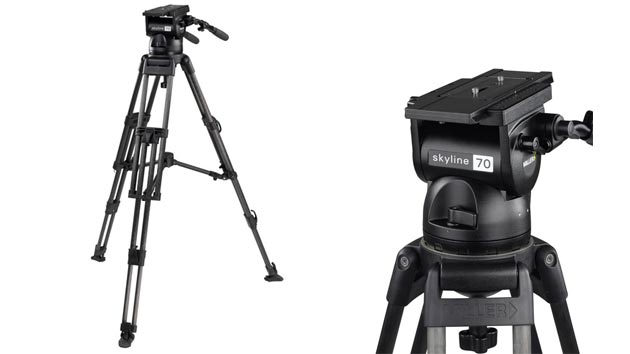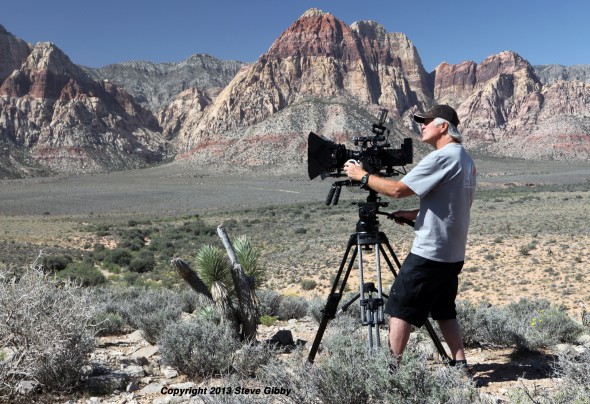A Versatile Support Solution for Both Cine and EFP/ENG
First Look
I was looking forward to trying out one of my Red Epic camera setups on the new Miller Skyline 70 head, supported by a Miller Heavy-Duty 2-Stage Carbon Fiber tripod. Though I’ve done extensive mobile production with the Miller Arrow 55 head/Sprinter II CF legs combo, and with smaller camera systems using the Miller Compass 25 head/Solo CF spreader-less legs combo, for the times when extreme mobility wasn’t needed I’ve felt that it would be great to use a larger, heavier 150mm-bowl head/legs system for my camera support. That’s precisely why I decided to test out the Skyline 70 system.
My first impression was that both the Skyline 70 head and the 2-Stage Carbon Fiber legs are well designed and strongly built. The fit and finish of the head and legs are quite good – definitely up the standards you’d expect in a flagship support system of this price. Both have the heft that lets you know that they can support just about any size camera setup you’d want to put on them. That said, for its dimensions and big payload rating, the head is still a relatively lightweight 13.2 pounds.
Miller rates the Skyline 70 head for an incredibly broad payload range of 9.9 to 82.5 lbs (4.5 to 37.5 kg). Depending on the camera setup, style of production, lens, and accessories, a Red Epic camera setup for 2D production can weigh anywhere from 10 lbs (4.5 kg) using lightweight, mobile hybrid Canon or Nikon lens setups (no matte box or follow focus) all the way up to 70 lbs (32 kg) using full cine-style lenses and accessories. Many modern digital cinema and hybrid camera systems (such as Red) are very modular, so users are constantly changing lens and accessory setups to suit the days shooting needs. Having one single head/legs combo that can span that payload range and still be relatively portable is a major plus for a production crew, and for a production budget. The Skyline 70 head/CF legs combo has an overall weight of 25.6 pounds (11.6 kg). That’s easily light enough to hand- or shoulder-carry (the system had a padded shoulder strap) into all but the most remote shooting locations.
Setting Up for Work
I chose to test out the Red Epic/Skyline 70 combination by shooting some 5k and 4k stock footage in the spectacular red rock country of the Southwest United States. Then, for a completely different production scenario, the Skyline 70 was also tested on a commercial production by my close associates from the Center for Media Innovation at Dixie State University. The Epic setup for the red rock country shooting was a mobile hybrid configuration, using a Nikon mount, Nikon 14-24 lens, follow focus, Anton Bauer brick (small), and the following Red accessories: Quickplate Module, 5” Touchscreen LCD, Top Handle, Pro I/O Module, Quick Release Platform, CF Matte Box, and Gunner Handles. That camera setup weighs around 28 pounds. In practice, the Skyline 70 counterbalance adjustments simply involve rotating a large, notched dial to an appropriate level on a scale of 1 to 8, the 8 being the heaviest head load, on down to 1 for the lightest head load. I found a setting of 3 worked very well for the Red Epic setup I was using. For the CMI commercial production a Sony F3 was used, very lightly accessorized with a Ruby 14-24 PL wide-angle lens, 15mm alloy rods, and a Zacuto follow focus. That camera setup weighed only 12 pounds – just a few pounds above the lightest load rating for the of the Skyline 70 head.
Tuning the head for the 7 selectable positions of pan-and-tilt drag was easily done by rotating the large notched wheels to the desired level of drag for each. Because I tightly track people, animals, and objects in a lot of my work I like a fair amount of tension on both pan and tilt. I was able to quickly tune the head to my liking.
I usually do a lot of high, mid-level, and low angles repeated throughout a shooting day, so quickly adjusting tripod legs are critical in my work. The flip levers on the CF 2-Stage Legs were really fast and easy to operate – simply flip the lever upward, raise or lower the tripod, then flip the lock back down. Quick, easy, and efficient. A mid-spreader is a must for mobile outdoor genres of production. A floor spreader is a nightmare outdoors, with the spreader tracks constantly getting clogged with dirt and debris. The Miller mid-spreader has small twist levers on all three pistons so that when you get the angle you want each tripod leg at, you simply turn the spreader levers to lock in the configuration.
Hard at work in my "office" for the day! Mobile outdoor production has obvious challenges. The Skyline 70 performed quite well with my Red Epic setup. The large-sized camera platform, its long travel adjustability and solid CF legs helped kep the long Epic rig stable, with the rig's center of balance where it should be.
Performance Impressions
So how did the Skyline 70/HD CF legs combo perform during my super-demanding mountain and desert fieldwork, and the CMI commercial production? In one word – impressive!
In red rock country, the two-stage CF legs, equipped with a mid-spreader and removable rubber feet, gave me the ability to quickly adjust the tripod for any surface. In dirt or loose rock I slipped the rubber feet off and used the hard metal leg spikes to dig in for grip. On flat rock surfaces I quickly slipped the rubber feet back on for a flat grip on the rock. The Heavy Duty CF legs are way strong and stable, but surprisingly light for their size. They’re rated for a maximum load of an incredible 209.4 pounds (95 kg) – well above the 82.5 lbs (37.5 kg) max load for the Skyline 70 head.
Using the flip lever on each leg I was able to quickly adjust the tripod all the way up to a max height of nearly six feet and all the way down to just over two feet. I found the Skyline 70 head, with its 8 positions of selectable counterbalance, 7 (plus zero) of selectable pan and tilt drag, and large camera plate, was glass-smooth in operation, and quickly adjustable for the Red Epic load. The telescopic panhandle allowed me to quickly get the right length of handle for each shot sequence.
When changing locations it was simple to release the head quick plate via the sliding lever under the back of the camera platform, lift the camera off the tripod, twist all three spreader tightening levers, flip up all three leg levers, collapse and fold the tripod, sling it over my shoulder via the padded strap (or use the installed carry handle on the side), and simply hike into the next location. The bottom line is that I found the Skyline 70/HD CF legs combo to be very portable, easy to adjust for each shot sequence, solid, well crafted, and extremely smooth in both pans and tilts. This is a high-quality tripod combination. In field use, it should bring a smile to any camera operator, cinematographer, or videographer.

Ben Braten of CMI and his crew put the Sony F3/Ruby 14-24/Skyline 70 setup to good use on a commercial production. Though the setup only weighed 12 pounds, the counterbalance was easily adjusted and the head performed smoothly.
In use on the CMI commercial production, the Heavy Duty CF legs with the rubber feet added were strapped right onto CMI’s platform dolly. Veteran cinematographer Ben Braten performed multiple simultaneous dolly/pan/tilt moves with the F3/Skyline 70 setup, while I shot stills of the crew working. Ben’s reaction to the Skyline 70 performance: “Easy to tune and adjust, very smooth through all pans and tilts, worked great with the light head load, and the CF legs are rock solid.”
My opinion of the Skyline 70/HD Carbon Fiber legs system supporting my Red Epic setup in mobile outdoor production and Ben’s opinion of the system supporting a lighter weight Sony F3 system paralleled each other, and yet there were very different head loads and shooting styles involved in each scenario. I have no doubt that the Skyline 70 system would also perform very well with even larger and heavier camera setups and head loads, right up to its rate limit of 82.5 pounds, and perhaps even beyond. In my sports and wildlife work I frequently use very long focal length lenses and heavier camera setups, so I’m quite used to how a head should perform in those scenarios. One of the head/legs combos I’ve used a lot in that work is a Miller Arrow 55 head/CF legs combo, which is the Skyline 70’s smaller relative. The Arrow 55 has performed exellent in those heavy camera scenarios, so I’d anticipate the Skyline 70 would perform even better with those camera setups.
In my opinion, a Skyline 70/Heavy Duty CF tripod system could benefit a production company in several ways, including versatility of head loads, solid platform, portability, and great fluid-head performance. Productivity should be increased by the very broad utility of the system, from small cameras to large cameras, mobile to stationary production, for either cine style or EFP/ENG style productions. If you use a wide range of camera setups and weights and shoot in a variety of styles and genres, this may very well be the high-end, deluxe tripod system that completely suits your needs.
About the Reviewer
Steve Gibby is a multiple Emmy Award winning producer, director, DP and cinematographer who has contributed to several hundred national television programs that aired on 18 different broadcast and cable network channels.












Leave a Reply